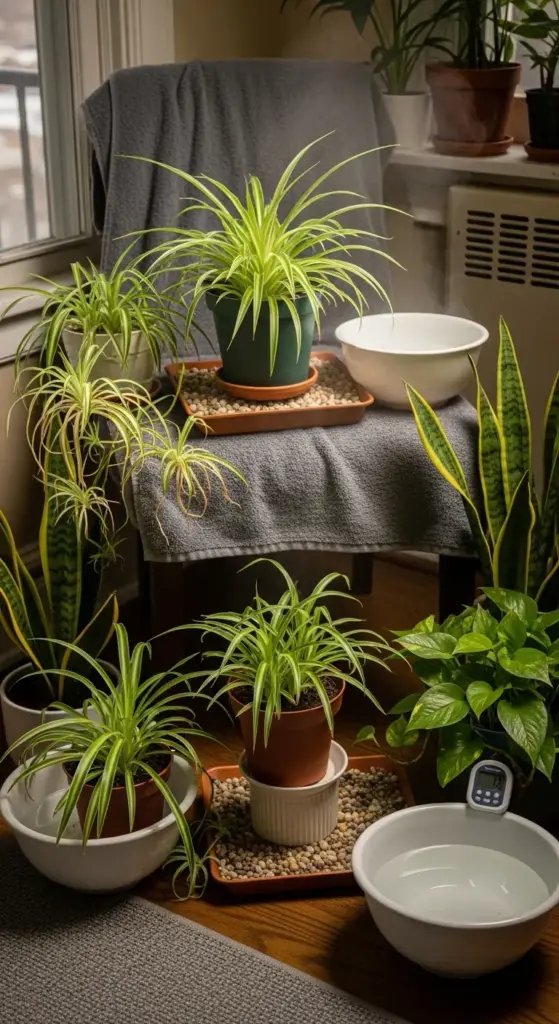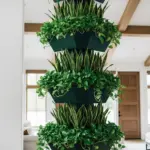Secret #4 – Humidity Hacks Using Household Items

My apartment in Chicago is basically the Sahara Desert during winter. I’m talking 20% humidity levels that make my spider plants look like they’re slowly dying of thirst, no matter how much I water them.
Those crispy brown leaf tips? That’s not overwatering or underwatering – that’s your plant literally gasping for moisture in the air.
The Towel Trick That Saved My Sanity
Before I discovered proper humidity solutions, I was that crazy plant lady misting her plants three times a day. Spoiler alert: misting doesn’t work and actually causes more problems.
Then I stumbled onto this genius hack using bath towels. I place a damp (not soaking) towel on a chair near my plant grouping and let it slowly evaporate.
It’s like a natural humidifier that raises the ambient humidity by about 10-15% in that immediate area. I refresh the towel every 2-3 days, and my spider plants went from crispy to lush within a month.
The Pebble Tray Method (Done Right)
Everyone talks about pebble trays, but most people set them up completely wrong. I know because I was one of those people for way too long!
Here’s the mistake: putting the pot directly on top of wet pebbles. This creates root rot faster than you can say “dead plant.”
The correct way? Use a shallow dish filled with pebbles and water, but place your plant pot on a small saucer that sits ON TOP of the pebbles. The pot never touches the water directly.
My DIY Apartment Solutions
Living in a dry climate taught me to get creative with household items. My favorite setup uses three large mixing bowls filled with water, strategically placed around my plant corner.
I add a few drops of vanilla extract to prevent that stagnant water smell. Sounds weird, but it works!
Another game-changer? Grouping plants together creates a natural microclimate. My spider plants, pothos, and snake plant all hang out together, sharing their transpired moisture like good roommates.
The Shower Method for Desperate Times
When my heating system went crazy last winter and dropped my humidity to desert levels, I discovered the emergency shower trick. This sounds insane but stick with me.
Once a week, I bring my spider plants into the bathroom and run a hot shower for 10 minutes with the door closed. They get a spa day in that steamy environment.
Just make sure the water isn’t hitting them directly, and let them dry off before moving them back. Steam therapy gave my plants the boost they needed to survive that brutal winter.
Monitoring Without Breaking the Bank
You don’t need fancy equipment to track humidity levels. I use a basic digital hygrometer from the hardware store – cost me like $8.
But here’s a free method: the ice cube test. Place an ice cube in a glass and watch how quickly condensation forms on the outside. Fast condensation means good humidity, slow or no condensation means your air is too dry.
Your spider plants will also tell you everything you need to know. Brown crispy tips mean low humidity, while soft mushy spots usually indicate too much moisture in the air.
Common Humidity Mistakes That Backfire
I used to think more humidity was always better. Wrong! I created a tropical rainforest situation that led to fungal problems and gnats everywhere.
Spider plants want 40-50% humidity, not 80%. Too much moisture in the air combined with poor air circulation is a recipe for disaster.
Also, never place humidifiers directly next to your plants. The constant moisture blast can cause leaf damage and create perfect conditions for spider mites.
The Winter Survival Strategy
During heating season, I set up what I call my “plant oasis” – a corner with grouped plants, a few water bowls, and that trusty damp towel system. It’s like a little greenhouse in my living room.
I also learned to move plants away from heating vents and radiators. That dry, hot air will crisp your spider plant leaves faster than you can blink.
Ready for the Feeding Secret?
Now that you’ve created the perfect humid environment for your spider plants, they’re probably growing like crazy and looking absolutely gorgeous. But here’s where most people mess up the momentum – they either overfeed or underfeed their thriving plants.
The homemade fertilizer recipe I’m sharing next costs literally pennies to make and will keep your spider plants producing those beautiful babies all season long!









GIPHY App Key not set. Please check settings